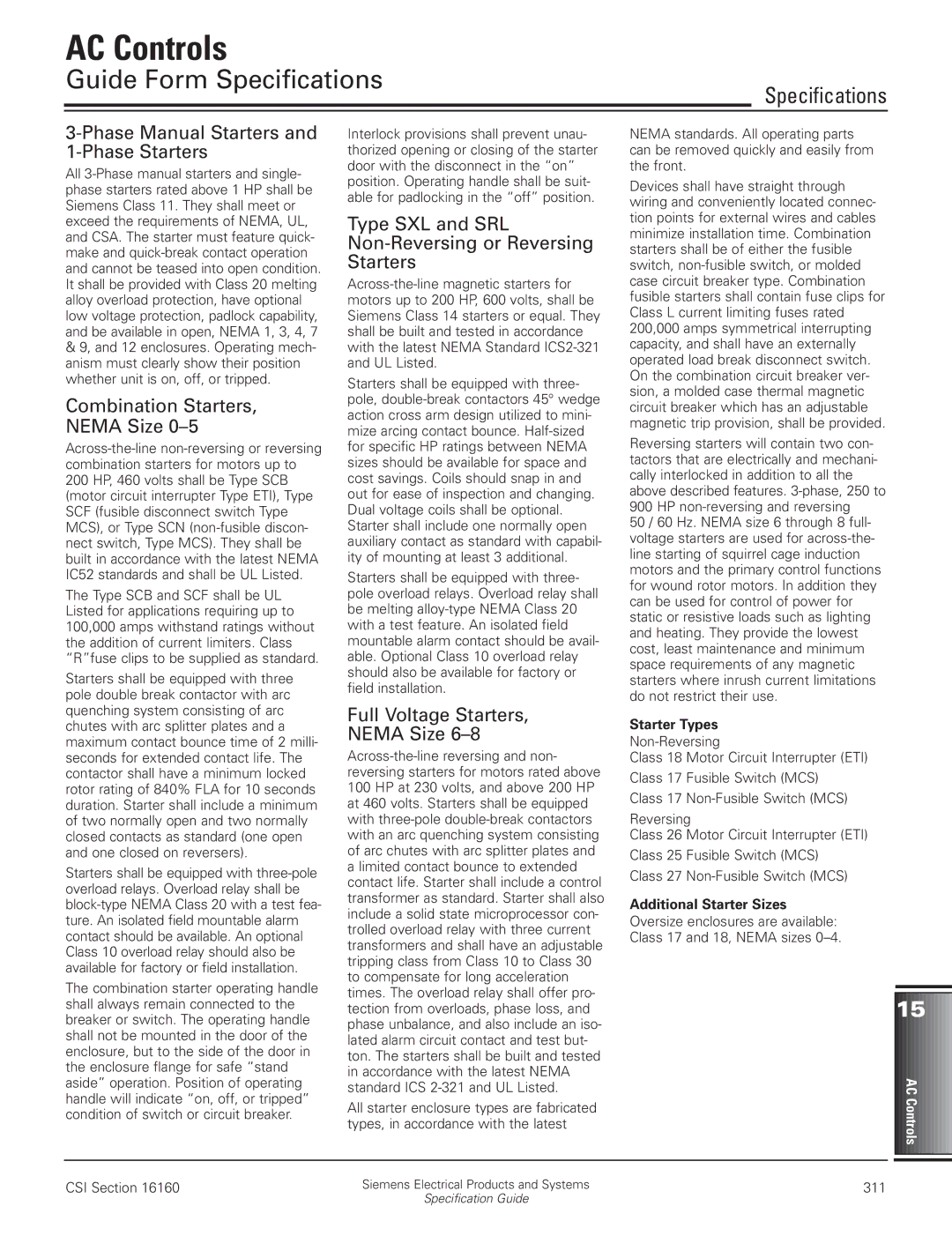3-Phase Manual Starters and
1-Phase Starters
All 3-Phase manual starters and single- phase starters rated above 1 HP shall be Siemens Class 11. They shall meet or exceed the requirements of NEMA, UL, and CSA. The starter must feature quick- make and quick-break contact operation and cannot be teased into open condition. It shall be provided with Class 20 melting alloy overload protection, have optional low voltage protection, padlock capability, and be available in open, NEMA 1, 3, 4, 7
&9, and 12 enclosures. Operating mech- anism must clearly show their position whether unit is on, off, or tripped.
Combination Starters,
NEMA Size 0–5
Across-the-line non-reversing or reversing combination starters for motors up to 200 HP, 460 volts shall be Type SCB (motor circuit interrupter Type ETI), Type SCF (fusible disconnect switch Type MCS), or Type SCN (non-fusible discon- nect switch, Type MCS). They shall be built in accordance with the latest NEMA IC52 standards and shall be UL Listed.
The Type SCB and SCF shall be UL Listed for applications requiring up to 100,000 amps withstand ratings without the addition of current limiters. Class “R”fuse clips to be supplied as standard.
Starters shall be equipped with three pole double break contactor with arc quenching system consisting of arc chutes with arc splitter plates and a maximum contact bounce time of 2 milli- seconds for extended contact life. The contactor shall have a minimum locked rotor rating of 840% FLA for 10 seconds duration. Starter shall include a minimum of two normally open and two normally closed contacts as standard (one open and one closed on reversers).
Starters shall be equipped with three-pole overload relays. Overload relay shall be block-type NEMA Class 20 with a test fea- ture. An isolated field mountable alarm contact should be available. An optional Class 10 overload relay should also be available for factory or field installation.
The combination starter operating handle shall always remain connected to the breaker or switch. The operating handle shall not be mounted in the door of the enclosure, but to the side of the door in the enclosure flange for safe “stand aside” operation. Position of operating handle will indicate “on, off, or tripped” condition of switch or circuit breaker.
Interlock provisions shall prevent unau- thorized opening or closing of the starter door with the disconnect in the “on” position. Operating handle shall be suit- able for padlocking in the “off” position.
Type SXL and SRL Non-Reversing or Reversing Starters
Across-the-line magnetic starters for motors up to 200 HP, 600 volts, shall be Siemens Class 14 starters or equal. They shall be built and tested in accordance with the latest NEMA Standard ICS2-321 and UL Listed.
Starters shall be equipped with three- pole, double-break contactors 45° wedge action cross arm design utilized to mini- mize arcing contact bounce. Half-sized for specific HP ratings between NEMA sizes should be available for space and cost savings. Coils should snap in and out for ease of inspection and changing. Dual voltage coils shall be optional. Starter shall include one normally open auxiliary contact as standard with capabil- ity of mounting at least 3 additional.
Starters shall be equipped with three- pole overload relays. Overload relay shall be melting alloy-type NEMA Class 20 with a test feature. An isolated field mountable alarm contact should be avail- able. Optional Class 10 overload relay should also be available for factory or field installation.
Full Voltage Starters,
NEMA Size 6–8
Across-the-line reversing and non- reversing starters for motors rated above 100 HP at 230 volts, and above 200 HP at 460 volts. Starters shall be equipped with three-pole double-break contactors with an arc quenching system consisting of arc chutes with arc splitter plates and a limited contact bounce to extended contact life. Starter shall include a control transformer as standard. Starter shall also include a solid state microprocessor con- trolled overload relay with three current transformers and shall have an adjustable tripping class from Class 10 to Class 30 to compensate for long acceleration times. The overload relay shall offer pro- tection from overloads, phase loss, and phase unbalance, and also include an iso- lated alarm circuit contact and test but- ton. The starters shall be built and tested in accordance with the latest NEMA standard ICS 2-321 and UL Listed.
All starter enclosure types are fabricated types, in accordance with the latest
NEMA standards. All operating parts can be removed quickly and easily from the front.
Devices shall have straight through wiring and conveniently located connec- tion points for external wires and cables minimize installation time. Combination starters shall be of either the fusible switch, non-fusible switch, or molded case circuit breaker type. Combination fusible starters shall contain fuse clips for Class L current limiting fuses rated 200,000 amps symmetrical interrupting capacity, and shall have an externally operated load break disconnect switch. On the combination circuit breaker ver- sion, a molded case thermal magnetic circuit breaker which has an adjustable magnetic trip provision, shall be provided.
Reversing starters will contain two con- tactors that are electrically and mechani- cally interlocked in addition to all the above described features. 3-phase, 250 to 900 HP non-reversing and reversing
50 / 60 Hz. NEMA size 6 through 8 full- voltage starters are used for across-the- line starting of squirrel cage induction motors and the primary control functions for wound rotor motors. In addition they can be used for control of power for static or resistive loads such as lighting and heating. They provide the lowest cost, least maintenance and minimum space requirements of any magnetic starters where inrush current limitations do not restrict their use.
Starter Types
Non-Reversing
Class 18 Motor Circuit Interrupter (ETI)
Class 17 Fusible Switch (MCS)
Class 17 Non-Fusible Switch (MCS)
Reversing
Class 26 Motor Circuit Interrupter (ETI)
Class 25 Fusible Switch (MCS)
Class 27 Non-Fusible Switch (MCS)
Additional Starter Sizes
Oversize enclosures are available:
Class 17 and 18, NEMA sizes 0–4.
15
AC Controls

